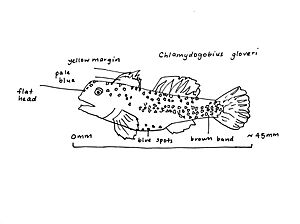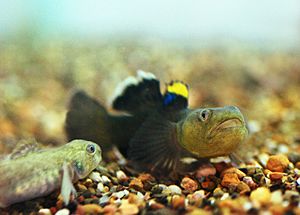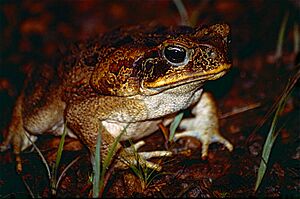Dalhousie goby facts for kids
Quick facts for kids Dalhousie goby |
|
|---|---|
 |
|
| Conservation status | |
| Scientific classification |
The Dalhousie goby (Chlamydogobius gloveri) is a small fish that lives only in the Dalhousie Springs in Australia. This means it is endemic to that area, found nowhere else in the world. It grows to about 4.5 cm (1.8 inches) long. Like many gobies, it eats tiny creatures like molluscs (snails) and crustaceans (shrimp-like animals).
Contents
What's in a Name? The Dalhousie Goby's Story
The scientific name for this fish is Chlamydogobius gloveri. The first part, "Chlamydogobius," comes from two older words. "Chlamys" is a Greek word meaning "cloak." "Gobius" is a Latin word for a type of fish called a gudgeon.
The second part, "gloveri," honors a scientist named John Glover. He used to be the Curator of Fishes at the South Australian Museum. John Glover studied many desert gobies in Australia. He was sure this goby was a special kind, different from others. But he didn't officially describe it himself.
Scientists first wrote about this fish in the 1980s. A famous Australian fish expert, Helen K. Larson, officially described the species in 1995.
Where Do Dalhousie Gobies Live?
The Dalhousie goby lives only in the Dalhousie Springs. These springs are found in Witjira National Park in South Australia. It's the smallest of five fish species that live only in these springs. The springs are like a closed-off water system. This means the fish have developed uniquely without much disturbance from other fish.
The Dalhousie Spring Complex has about 148 separate springs. All of them get their water from one big underground source. This source is called the Great Artesian Basin.
Out of these 148 springs, the Dalhousie goby can be found in about 28 of them. These fish like water temperatures from 21.6 to 36 degrees Celsius (70.9 to 96.8 degrees Fahrenheit).
They prefer shallow water and swampy areas. They especially like places with lots of phragmites (a type of tall reed grass) and other plants.
Scientists have studied the springs to understand where these fish thrive. They looked at things like water temperature, how many plants were there, and the size of the water body. They found that larger springs usually had more fish species, including the Dalhousie goby. They also learned that if a spring was big enough, you would almost always find Dalhousie gobies there.
This shows that the number and location of these fish depend on their features. For example, the goby is small and doesn't need a special diet. So, it can live in shallow, plant-filled areas. Other fish, like the perch, need different habitats because they hunt other animals.
Studies also showed that Dalhousie gobies can handle many different conditions. This includes changes in how salty the water is and how warm it gets.
What Does the Dalhousie Goby Look Like?
The Dalhousie goby has several unique features. It is usually light grey, almost silver. Compared to other desert gobies, its colors are more subtle.
It's a small fish, growing to about 4.5 to 6 cm (1.8 to 2.4 inches) long. It has two dorsal fins (on its back) and about fifteen vertebrae (backbones). It also has fifteen caudal fin rays (bones in its tail fin).
The goby's eyes are high up on its wide, flat head. You can often tell male gobies from female gobies. Males usually have larger teeth. Females are paler in color. Female gobies also have blue spots in the middle of their main fins. Male gobies have a light blue stripe through the center of their main dorsal fin. This stripe is outlined by a pale yellow edge. The color of the Dalhousie goby's pelvic fins (on its belly) can be clear white to clear brown. Males generally have darker fins than females.
Dalhousie gobies are not very strong swimmers. They have a special organ in their throat called a pharyngeal organ. This organ helps them breathe by taking oxygen from the water and even from the air around them.
These fish are active during the day. They are completely harmless to humans.
Breeding and Diet of the Dalhousie Goby
Scientists don't have a lot of specific studies on the Dalhousie goby. So, much of what we know about them comes from studying other types of desert goby species.
Dalhousie gobies lay eggs instead of giving birth to live young. They are called "benthic spawners" because they lay their eggs on the bottom. They use rock cavities to lay their sticky eggs. These eggs attach themselves to the rocks. Once the eggs are laid, the male goby guards them. He fans the eggs almost constantly with his fins. This helps the eggs get enough oxygen until they hatch.
Scientists estimate the number of eggs laid by comparing them to another goby species, Chlamydogobius eremius. That species lays about 150 to 300 eggs. The Chlamydogobius eremius also helps scientists guess how long it takes for the eggs to hatch. They think Dalhousie goby eggs hatch in about ten days. Their breeding season happens during the Australian summer months. A generation of Dalhousie gobies lasts about half a year.
Like other goby species, the Dalhousie goby eats both plants and animals. This means they are omnivorous. Most of their diet is made up of thread-like algae. Based on what other gobies eat, Dalhousie gobies likely feed on the bottom. They eat smaller crustaceans and insects. Sometimes, adult gobies have even been seen eating younger fish of their own kind.
Protecting the Dalhousie Goby: Status and Threats
In 1999, the Dalhousie goby was listed as a vulnerable species. This means it was at risk of becoming endangered. But in 2019, the IUCN Red List of Threatened Species changed its status. It is now considered critically endangered. This means it faces a very high risk of disappearing from the wild.
Many things threaten the Dalhousie goby. These include drilling in their habitat, human activities, and changes to the landscape. Also, new plants and animals that don't belong there, disturbance from farm animals, and tourism can harm them. The Dalhousie goby is critically endangered because of these threats. Also, it only lives in the Dalhousie Springs, making it very sensitive to changes.
Drilling and Spring Changes
Drilling for water causes problems for the Dalhousie goby. It reduces the amount of surface water available. This changes the plants and water in the springs. Since the 1800s, people have drilled in the Great Artesian Basin. This has led to less water flowing from the springs. When spring flows are reduced or stop, the number of fish in those springs drops. Sometimes, fish can even disappear from a local spring. With less living space, these unique fish become crowded in fewer springs. Their overall numbers have gone down. Many of these boreholes are still active. It's hard to close them because of legal reasons.
Changing the springs by digging is another threat. This digging was often done because people wrongly thought it would make more water flow. It also harms the natural balance of the springs.
New Plants and Animals
New plants and animals that are not native to the springs can cause problems. They compete with the goby for food and resources. They might even eat the gobies. For example, the Eastern Gambusia fish has been found in the springs. Humans likely brought these fish from about 100 km (62 miles) away. These fish are considered harmful water pests. They have been living in the artificial water areas created by drilling.
Cane toads are also dangerous because they eat small creatures. Cane toads have been seen in the eastern part of the Great Artesian Basin. Also, the Government of South Australia worries that crayfish might be put into the springs on purpose. Crayfish could also compete with the goby for food or even eat them.
Plants that are not native to the area also threaten the Dalhousie goby. Farmers introduced the date palm in the late 1800s. These trees have now spread in some parts of the Dalhousie Springs. Date palms have very deep roots and use a lot of water. This reduces the amount of surface water in the springs. When water levels drop, goby populations shrink, and they can disappear from local areas.
Other non-native plants that are a risk include certain grasses, bamboo, and athol pine. Bamboo and athol pine have spread across other springs in South Australia. They could spread to the Dalhousie Springs, affecting the food available to the gobies. Grasses can also change the natural balance within the springs. Birds likely spread these grasses from nearby wetlands.
Humans and Farm Animals
Humans have been interacting with the Dalhousie Springs for about 40,000 years. For most of that time, these interactions were gentle. Practices like cultural burning helped the environment. Cultural burning was good for the goby because it helped keep their open water habitats clear. When Europeans arrived about 200 years ago, cultural burning stopped.
Today, many tourists visit the springs. This can harm the environment. The government tries to control tourism with signs and barriers. But ongoing management is needed to prevent damage. Possible damage from tourism includes people walking on sensitive areas. Also, unauthorized bathing can pollute the water with products like sunscreen and detergents.
Farm animals like donkeys, cattle, and camels also cause problems. Their grazing and trampling damage the natural mineral balance in the springs. Their walking makes the ground muddy and weakens it. This changes the water's mineral makeup. While the goby can handle many water conditions, other animals in the springs are more sensitive.
Farm animals have slowly changed the ecology of the springs. The area used to have more native species. Now, it has more species that can handle harsher conditions.
Efforts to Save the Dalhousie Goby
Several groups are working to protect the Dalhousie Springs and its unique species. These include the National Parks co-managers, the South Australian government, and the Witjira National Park Board.
The South Australian Government has made recommendations to help save the springs. They suggest more efforts to close and control boreholes. This will help keep the water flowing from the springs at healthy levels.
To deal with farm animal disturbance, the government recommends proper fencing. This would make sure animals graze only in suitable areas. The goal is to control the animals, not remove them completely. Removing them might allow non-native plants to grow too much, harming native plants.
The South Australian Government also wants to control the threat from non-native plants and animals. They encourage methods like shooting, baiting, and trapping wild animals, especially feral pigs. They also support preventing and removing non-native plants and animals. This includes the Eastern Gambusia fish and the date palm. Strict monitoring programs are also important. In recent years, cultural burning has been successfully brought back in some springs. It has helped control the growth of non-native plants like the date palm.
The recommendations also include teaching people about the risk of accidentally moving tiny living things from one spring to another. This often happens when people don't clean their footwear. Visitors should clean their shoes to reduce these risks and protect the habitat. Damage from tourism has been reduced by regulations. These rules now ban activities like fishing and boating. They also ban pollutants like chemicals. Swimming is now allowed in only one pool in the springs. This helps protect the rest of the sensitive spring areas.
Conservation efforts also focus on accurately counting the populations of unique species. They also track where these species live by creating a detailed list. To help increase numbers, the South Australian Government encourages more research into the habits, biology, and ecology of the species. This research will help create the best possible habitat for the Dalhousie goby to thrive.





